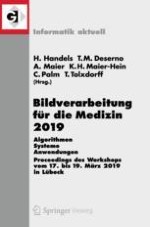2019 | Buch
Bildverarbeitung für die Medizin 2019
Algorithmen – Systeme – Anwendungen. Proceedings des Workshops vom 17. bis 19. März 2019 in Lübeck
herausgegeben von: Prof. Dr. Heinz Handels, Prof. Dr. Thomas M. Deserno, Prof. Dr. Andreas Maier, Dr. Klaus Hermann Maier-Hein, Prof. Dr. Christoph Palm, Prof. Dr. Thomas Tolxdorff
Verlag: Springer Fachmedien Wiesbaden
Buchreihe : Informatik aktuell
